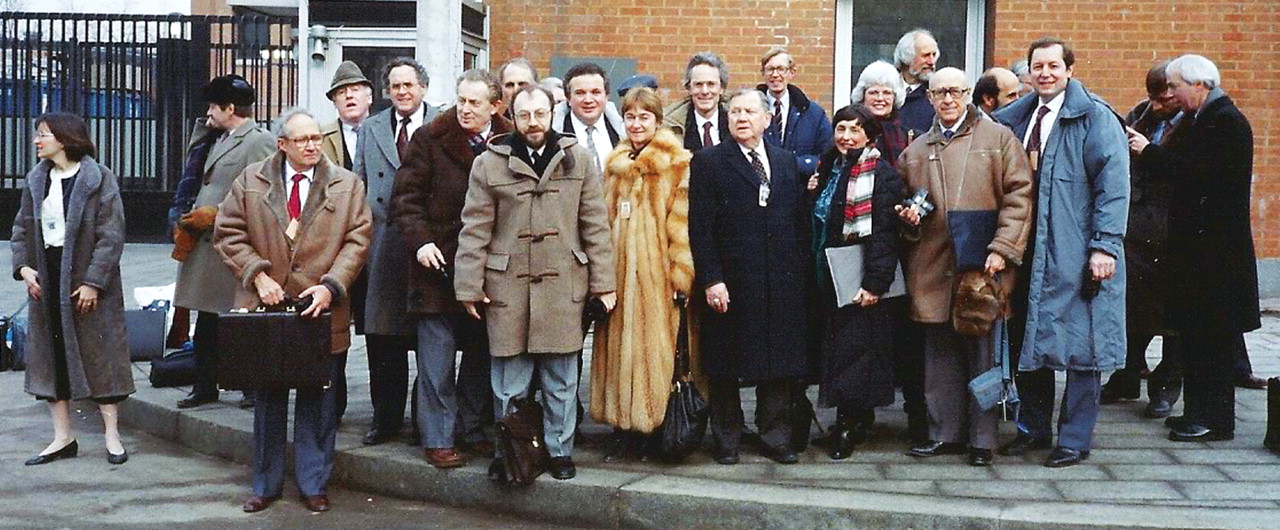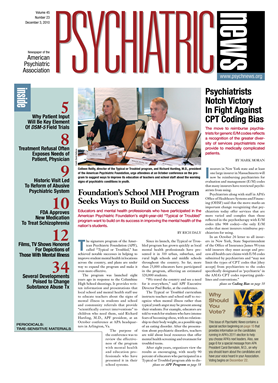Twenty-five years after Soviet war hero General Pytor Grigorenko was incarcerated in a psychiatric hospital following his protest of human-rights abuses, and 18 years after Vladimir Bukovsky released to the Western press copies of forensic reports on Grigorenko and five other Soviet human-rights activists who had been similarly detained, the Soviet Union was in turmoil.
Grigorenko's incarceration and the release of the “Bukovsky papers” were sentinel events in the growing awareness among Western psychiatrists of the Soviet practice of using psychiatric hospitalization—sometimes augmented by use of drugs—to punish and contain political dissent.
The subject had dominated the 1977 meeting of the World Psychiatric Association (WPA) in Honolulu, resulting in a resolution censuring the Soviet All-Union Society of Psychiatrists and Neuropathologists. Prior to the follow-up meeting in 1983 in Athens, Greece, the All-Union Society withdrew from the world body, under threat of expulsion. Throughout the 1980s, APA's Committee on International Abuse of Psychiatry sought contact with incarcerated individuals believed to be held for nonmedical reasons (Psychiatric News, November 5 and November 19).
But change was brewing in the U.S.S.R., and by 1989 Mikhail Gorbachev was in power promising perestroika—a comprehensive restructuring of Soviet politics and economy—and glasnost, a policy of openness and transparency.
Hoping to revitalize a stagnant economy, Gorbachev and his ministry of foreign affairs, under the leadership of Eduard Shevardnadze, sought better ties with Europe and the United States, including a readmission of the All-Union Society to the WPA. But for that they needed to demonstrate adherence to the human-rights stipulations of the 1975 Helsinki Accords, which they had long ignored, including an end to the use of psychiatric hospitalization to detain political dissidents.
What would evolve from negotiations between the U.S. State Department and the Soviet Ministry of Foreign Affairs—with the crucial participation of the National Institute of Mental Health (NIMH) and APA—was a remarkable diplomatic endeavor to systematically investigate claims by humanrights activists who said dissidents were still being detained in psychiatric facilities and to assess more generally the state of Soviet psychiatric practice.
In late February 1989, a delegation of 26 psychiatrists, forensic experts, Sovietologists, and APA staff (including Ellen Mercer, director of APA's Office of International Affairs) traveled to the U.S.S.R. to conduct systematic videotaped interviews with hospitalized and released psychiatric patients and their relatives, and to investigate conditions at Soviet psychiatric hospitals.
“It was an extraordinary visit and a very well-coordinated work of diplomacy involving three major organizations—the State Department, APA, and the National Institute of Mental Health,” recalled forensic psychiatrist Loren Roth, M.D., who was the psychiatric leader of the American delegation. “It took an enormous amount of planning and preparation to accomplish two fundamental purposes—a truly valid scientific assessment of Soviet psychiatry, including its diagnostic procedures, and assessment of the extent of abuse of psychiatry.”
Most extraordinary was the unusual degree of access accorded the delegation: the Americans interviewed and videotaped patients—and where possible their relatives—without interference from authorities and in a neutral setting. Released patients were interviewed in a hotel room, while hospitalized patients were transferred and interviewed in a single Moscow hospital. The delegation was able to access records, collect urine samples, and assess the validity of Soviet diagnoses against American standards.
Moreover, they were allowed to enter Soviet psychiatric hospitals—including some of those most notorious for housing political dissidents—and interview patients at will.
“We were later told by the State Department and [then] Ambassador for Human Rights Richard Shifter that this was likely the most invasive human interchange one nation had ever conducted in another nation in the area of medical investigation,” Roth told Psychiatric News.
It was a measure of the change under way in the U.S.S.R. and of the desperation on the part of the Soviet government to rejoin its economy with the Western world. As delegation member William Carpenter, M.D., remarked, “Sovereign nations just don't normally allow this kind of invasiveness.”
Snapshot of a System in Flux
The visit took place in an atmosphere of high drama and some tension. Memories of the trip, as related by delegation members to Psychiatric News, include some dramatic flourishes—among them a former patient, then on the run, who was briefly interviewed while in hiding; and more than one delegation member recalled eyebrow-raising approaches from prostitutes and merchants of black-market contraband, which were regarded as efforts to ensnare members of the delegation in compromising situations.
But the grave purpose was evident in the remarkable “snapshot” of a Soviet psychiatric system in flux that emerged and was recorded in a special book-length issue of Schizophrenia Bulletin titled “Assessment of Recent Changes in Soviet Psychiatry” published in English with side-by-side Russian translation. (The book appears as a supplement to Schizophrenia Bulletin, volume 15, number 4, 1989.)
APA Director of Research Darrel Regier, M.D., M.P.H., who was at the time director of the Division of Clinical Research at NIMH, designed and implemented—along with Deputy Director Samuel Keith, M.D.—the standardized assessment methods used in the interviews.
Three teams—headed by a research psychiatrist and including a Russian-speaking psychiatrist, a forensic psychiatrist or psychologist, and two professional interpreters provided by the State Department—interviewed patients. The sample of patients for the interviews was derived from Amnesty International, a State Department list of possible dissidents, the National Academy of Sciences, and the International Association on the Political Use of Psychiatry.
That list included 33 then-hospitalized patients and 12 individuals who had been released from hospitals within the previous two years. Of the 33 hospitalized patients, 17 were released prior to or concurrent with the delegation visit in what Regier called “the most miraculous recovery from mental illness ever visited upon a country.”
Of the 16 remaining hospitalized patients, the U.S. team found evidence of severe psychotic disorder in nine patients, with diagnoses that broadly corresponded to those of the Soviet psychiatrists. Five of the hospitalized individuals, however, were found to have no mental illness at all, including one who had been diagnosed with schizophrenia following a period of active involvement in human-rights protests.
Additionally, the U.S. team found that neuroleptic medications had been used to treat patients for “delusions of reformism” and “anti-Soviet thoughts” in the absence of accepted indications of psychosis. Charges of the use of sulfazine injections, ostensibly to enhance neuroleptic treatment but typically producing pain, immobility, and muscle necrosis (suggesting punitive rather than therapeutic purposes), were also confirmed by the American delegation.
Among the 12 recently released patients, the U.S. team found no evidence of past or current mental disorder in nine, and the remaining three had mild symptoms that would not typically warrant involuntary hospitalization in Western countries (see
‘Hyperdiagnosis’ Found Pervasive).
Emergence of Independent Civil Society
The denouement of the remarkable confrontation between Western and Soviet psychiatry in the 1970s and 1980s—culminating in the 1989 delegation visit—was complex and not to everyone's liking.
At the meeting of the WPA that year in Athens, Greece, the All-Union Society was readmitted to the world body with conditions that some—such as Dutch human-rights activist Robert van Voren (author of a new book this year, Cold War in Psychiatry: Human Factors, Secret Actors)—considered weak and that were, in van Voren's view, largely ignored. Soviet psychiatry would remain well behind the West in standards of care, with some of those most culpable for past abuses still in power at the time of their readmittance to the WPA.
Others, like former APA medical director Melvin Sabshin, M.D., whose leadership was central throughout, said the most blatant state-sponsored abuses were ended and that the episode was a victory for ethics and for an empirical, evidence-based psychiatry over ideology.
Regier pointed to a follow-up visit of Soviet psychiatrists to the United States in 1990 in which they witnessed Western standards of care, and to renewed dialogue generally that included joint initiatives on mental health consequences of disaster and on treatment of depression in primary care.
He added that the 1989 visit and the publication of the Schizophrenia Bulletin report in Russian aided in the emergence over time of a new generation of psychiatrists determined to protect the profession from the arm of the state.
“One of the benefits of the report was to help them understand what had happened to their society and to their profession,” Regier said.
That viewpoint was echoed by delegation member Richard Bonnie, J.D., a professor of law and medicine at the University of Virginia School of Law. “One of the most important lessons from the period is the importance of a civil society, including independent professional organizations, separate and apart from the state,” he told Psychiatric News. “The deformed nature of the Soviet psychiatric profession is one of the explanations for why it was so easily bent toward the repressive purposes of the state.
“So one of the things we wanted to support was the emergence of truly independent professional organizations that could develop and enforce codes of ethical conduct, advocate for the well-being of patients, and, when necessary, criticize regressive policies proposed by the state.”


